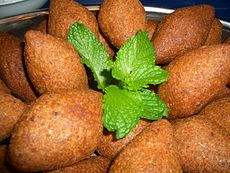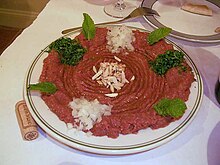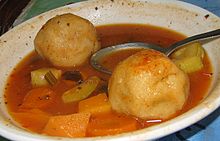Kibbeh
 Fried kibbeh Raas (Nabulsi kibbeh) with peppermint | |
| Course | Meze or mezze /ˈmɛzeɪ/ |
|---|---|
| Place of origin | Levant |
| Region or state | Armenia, Brazil, Cyprus, Egypt, Iran, Iraq, Israel, Jordan, Lebanon, Palestine, Syria and Turkey |
| Serving temperature | Hot |
| Main ingredients | Finely ground meat, cracked wheat, and Middle Eastern spices |

Kibbeh (Arabic: كبة), (also spelled and pronounced kibbe, kebbah, kubbeh, kubbah or kubbi depending on region, and known in Egypt as kobeiba and in Turkey as içli köfte) is a Levantine dish[1] made of bulgur, minced onions, and finely ground lean beef, lamb, goat, or camel meat with Middle Eastern spices (cinnamon, nutmeg, clove, allspice).
Other types of kibbeh may be shaped into balls or patties, and baked, cooked in broth, or served raw.[2] Kibbeh is considered to be the national dish of many Middle Eastern countries.[3]
Kibbeh is a popular dish in Middle Eastern cuisine.[4] Mainly, it is found in Lebanon,[5] Syria,[5] Palestine, Jordan, Egypt (kubbeh, kebbah, or koubeiba),[5] Iraq,[5] as well as Armenia (Keufteh, ltsonvats kololak), Iran,[5] Israel,[5] Cyprus (koupa, plural koupes) and in Turkey it is called içli köfte.[5]
It is also found throughout Latin American countries which received substantial numbers of Levantine immigrants during the late 19th and early 20th centuries.[6]
Etymology
The word is derived from the Classical Arabic kubbah (kibbeh in North Levantine Arabic), which means "ball".[7] Various transliterations of the name are used in different countries: in English, kibbe and kibbeh and in Latin America, quibe, kibe, or quipe (Argentina).
Variations


In Levantine cuisine, a variety of dishes made with bulghur (cracked wheat) and minced lamb are called kibbeh. The northern Syrian city of Aleppo (Halab) is famous for having more than 17 different types.[8] These include kibbeh prepared with sumac (kibbe sumāqiyye), yogurt (kibbe labaniyye), quince (kibbe safarjaliyye), lemon juice (kibbe ḥāmḍa), pomegranate sauce, cherry sauce, and other varieties, such as the "disk" kibbeh (kibbe arāṣ), the "plate" kibbeh (kibbe biṣfīḥa or kibbe bṣēniyye) and the raw kibbeh (kibbeh nayyeh).
Kibbeh nayyeh is a raw dish made from a mixture of bulghur, very finely minced lamb or beef similar to steak tartare, and Middle Eastern spices, served on a platter, frequently as part of a meze in Lebanon and Syria, garnished with mint leaves and olive oil, and served with green onions or scallions, green hot peppers, and pita/pocket bread or markouk bread.
Kubba Halab is an Iraqi version of kibbeh created with a rice crust and named after the largest city in Syria, Aleppo. Kubba Mosul, also Iraqi, is flat and round like a disc. Kubbat Shorba is an Iraqi-Kurdish version prepared as a stew, commonly made with tomato sauce and spices.[9] It is often served with arak and various salads. The Iraqi versions are part of the same versions eaten in Iran.[5]
A Syrian soup known as kubbi kishk consists of kubbi "torpedoes" or "footballs" in a yogurt (kishk) and butter broth with stewed cabbage leaves. Another soup, known as kibbeh hamda, consists of a chicken stock with vegetables (usually leeks, celery, turnips and courgettes), lemon juice and garlic, with small kibbeh made with ground rice as dumplings.[10][page needed] In the Syrian Jewish diaspora this is popular both at Pesach and as the pre-fast meal on the day before Yom Kippur.[11][better source needed]
See also
- Error: too many portals (maximum = 1)
- Middle Eastern and Levantine cuisine
- Brazilian cuisine
- Cypriot cuisine
- Haitian cuisine
References
- ^ Annia Ciezadlo (2012). Day of Honey: A Memoir of Food, Love, and War. p. 361. ISBN 1-4391-5753-7.
- ^ "Contemporary kubbeh". jpost.com. Retrieved 13 November 2017.[permanent dead link]
- ^ "ORBITZ.com – Best Travel Deals". away.com. Retrieved 13 November 2017.
- ^ "Middle Eastern Recipes". www.mideastweb.org. Retrieved 13 November 2017.
- ^ a b c d e f g h Davidson; et al. (2014). The Oxford Companion to Food. Oxford: Oxford University Press. pp. 444–445. ISBN 978-0191040726.
{{cite book}}: Explicit use of et al. in:|author=(help) - ^ "Burghul meatballs with hot sauce (quibe)". sbs.com.au. Retrieved 13 November 2017.
- ^ Maan Z. Madina, Arabic-English Dictionary of the Modern Literary Language, 1973
- ^ "NPR web: Food Lovers Discover The Joys Of Aleppo".
- ^ "Kibbe at the Crossroads: A Lebanese Kitchen Story". npr.org. Retrieved 13 November 2017.
- ^ Claudia Roden, A Book of Middle Eastern Food
- ^ Poopa Dweck, Aromas of Aleppo.
- Appetizers
- Arab cuisine
- Armenian cuisine
- Assyrian cuisine
- Cypriot cuisine
- Dumplings
- Egyptian cuisine
- Iranian cuisine
- Iraqi cuisine
- Israeli cuisine
- Jordanian cuisine
- Kurdish cuisine
- Lebanese cuisine
- Levantine cuisine
- Palestinian cuisine
- Syrian cuisine
- Turkish cuisine
- Western Armenian cuisine
- Stuffed dishes
- Meatballs
- National dishes
